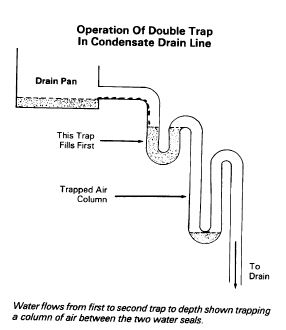Get Tech Tips
Subscribe to free tech tips.
Discovering Mental Reference Points
Trying to wrap your head around HVAC can feel like a constant firehose of new info, right? Whether you're in class or on the job, there's just so much to soak up. And when you finally think you've got one thing down, BAM, here comes another concept. For me, remembering everything can be a real struggle, especially if it's been a while since I last saw it.
So, what I do is look for little things I can latch onto to help make sense of the bigger picture. The 90-380 relay has become one of those things for me—it's like a mental hook that connects a bunch of different electrical ideas.

For example, it helps me see the difference between the low-voltage circuit that controls things and the high-voltage circuit that actually does the work. The way it's set up makes it easy to keep those two types of circuits separate in my head. It really clicked for me when I realized the relay was just a fancy switch for the indoor blower motor. That got me thinking about how much power that motor needs and how it gets turned on and off. Obviously, the blower motor needs some serious voltage, and without something like the 90-380 to break the flow, it would just run non-stop. But it's important to remember that the relay isn't the brains of the operation; it just does what it's told.
That's where the whole low-voltage control circuit idea comes in. The 90-380 relay deals with both the low and the high-voltage circuits. The high-voltage side is connected to those normally open terminals, just waiting for the low-voltage signal to fire up the coil and activate the switching mechanism. Seeing how the 90-380 keeps these jobs separate really helps me picture the difference between high and low-voltage circuits.

Continuity and Resistance
The 90-380 relay was how I first really got my head around resistance and continuity, two things that trip up a lot of new HVAC techs. It's easy to mix them up since you use the same setting on your meter, and sometimes the difference between resistance and continuity isn’t made super clear in trade school or on-the-job training.

I like to think of it like this while envisioning the 90-380 in my mind: continuity just means there's an unbroken path for electricity to flow between two spots.

The 90-380 shows this with its normally open (NO) and normally closed (NC) terminals. When the relay is off, those NO terminals don't have a connection, so your meter won't beep. But when that voltage kicks in and closes the NO contacts, boom, a path is made, and your meter rings. Conversely, the NC terminals have a connection when the relay is off, so your meter will beep when applied to those terminals. When low voltage kicks in, the NC terminals open, breaking the continuous path, and your meter will stop ringing.

Continuity checks can be very useful for an HVAC technician during the troubleshooting phase, especially when checking fuses, relays, and contacts. But don’t think that everything is okay just because your meter beeps. Sometimes, there will be continuity, but the resistance is too high.
Resistance
Now, resistance is different. It's all about how much something gets in the way of the electrical flow, and we measure it in ohms. Continuity just tells you if there's a road; resistance tells you how bumpy that road is. For example, a good closed relay should have almost no resistance (close to zero ohms) so that it doesn't block the electricity the blower motor needs. However, if the relay contacts are dirty or pitted, they can exhibit increased resistance, even when closed. The added resistance can slow down the blower motor or even stop it, and the bad connection can even get hot. So, you might still have a path (continuity), but the resistance is way too high.

A Path Back
The 90-380 really hammered home for me how crucial it is to have a common wire or a way for the electricity to get back and complete the loop. This relay uses an electromagnetic coil to flip the switch on and off.

Usually, that coil gets its power (usually 24 volts) from the thermostat, often through the G wire. The thermostat's basically telling the relay what to do by sending that 24 volts. But here's the thing: just because the G wire is sending voltage to the coil doesn't mean anything happens. That coil needs a full circle, a path back, to actually get energized and make the switch work. That's where the common wire steps in.

Even though I still don't totally get the whole “path back” thing, the 90-380 really helps me out when I'm wrestling with low-voltage issues. It seems like a lot of us newer techs just focus on the hot wires when we're trying to figure things out and totally forget about the common wire. I can't even count how many times I was about to lose it with frustration, and then I'd think back to messing with that 90-380 and pulling the common wire on and off when I was learning. So, I'd start checking all the common connections, and wouldn't you know it, a common wire had slipped out of its connector. Once the common wire was reconnected, the problem was solved.
Conclusion
In the often overwhelming world of HVAC, finding anchors for understanding complex systems is crucial. The 90-380 relay serves as a tangible link for me, acting as a bridge between abstract electrical concepts and real-world applications. By focusing on this seemingly simple component, the distinction between high- and low-voltage circuits becomes clearer, the concepts of continuity and resistance gain practical meaning, and the vital role of a complete electrical path, particularly the often-overlooked common wire, is brought into sharp focus.
But it doesn’t have to be this particular relay that you use. The point is to find something that sits well in your memory. Something you don’t have to struggle to consider, that is ready for you to use when needed. The goal is to identify simple things that will help you connect the dots in more complicated components or concepts. This will transform the daunting firehose of HVAC information into a more manageable and relatable series of concepts, ultimately empowering you to troubleshoot and understand systems with greater clarity and confidence.
For more experienced techs. What is your anchor? What is that one little component or device that you have used to help you tie together concepts and make it day to day, never knowing what you might see on your next call? Maybe you didn’t even realize it was your anchor. Share it in the comments, and maybe someone else could adopt your perspective and become a stronger technician.
—JD Kelly








Comments
To leave a comment, you need to log in.
Log In